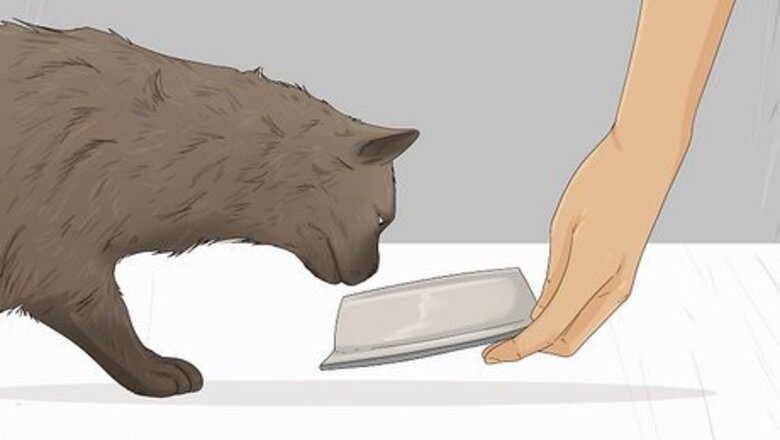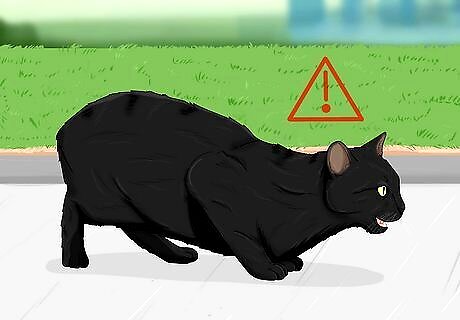
views
- Leave out food in the same spot each day around the same time so that the stray cat learns to come to you when they're hungry.
- Don’t try to pet or pick up the stray cat. Instead, sit very still and quietly outside while the cat is eating and let the cat approach you on their own time.
- Maintain your distance if the stray shows any signs of aggression or distress, such as hissing or growling.
Gaining a Stray Cat’s Trust

Set out food and water at the same time each day. The fastest way to earn a stray cat’s trust is through their stomach. Leave out a bowl of fresh water at all times and bring out dry or wet food around the same time each day and in the same location. By doing this, you’ll be able to monitor the stray more easily. The cat will also come to see you as a reliable source of food and learn to come to you when it’s hungry. Change out the water 2 or 3 times a day to make sure it stays fresh. Select strong-smelling food to more easily attract a stray cat. Canned food is usually more pungent than dry food, especially fish flavors like salmon and tuna. Avoid giving the cat human food, such as canned tuna or fish, milk, or cream. This can upset their digestive system.

Provide the cat with a warm place to sleep, such as in your garage. Giving a stray a safe and warm place to sleep will help reduce any stress they’re feeling and keep them safe from harsh weather conditions. One idea is to open your garage door about a foot (30.5 cm) wide and leave a cat bed or a comfy towel for the cat to sleep on. Another option is to place insulating materials, such as straw, in a cardboard box and leave it in your garage or shed. Another option is to make an insulated cat house by lining a plastic storage container with styrofoam and cutting out a hole for the stray to enter.

Let the cat approach you before attempting to pet them. Earning a cat’s trust is all about letting them come to you on their own time. In the beginning, simply observe the cat from inside your home. After a few days, step outside while the cat is eating, but remain very still. Avoid making any noise and don’t make eye contact with the cat. Do your best to crouch low to the ground to make yourself appear smaller and wait for the cat to approach you when they're ready. Don’t try to pet or interact with the cat physically during this time unless the cat makes contact with you first by rubbing against your legs or nuzzling you.

Watch for signs of aggression, such as hissing or growling. If the stray's ears are flattened, their mouth is open in a hiss, or their hackles are raised, these are all signs that they are feeling threatened. If that’s the case, don’t try to approach the stray. Instead, leave them alone for a day or two, but still continue to bring them food and water. After a few days, resume sitting outside quietly while the cat is eating. Maintain your distance and let the cat approach you when they're ready. Keep in mind that a stray may go from showing a lot of trust one day to becoming skittish the next. Just remain patient and keep up a consistent routine.
Determining if a Cat is Stray or Feral

Look for dirty, disheveled fur on a stray. Sadly, stray cats are cats who have been lost or abandoned by their previous owners and often have a difficult time adapting to life in the wild. Because of this, stray cats will often appear very dirty or disheveled. On the other hand, feral cats are cats that have been living outdoors their entire lives and have never had an owner. These cats will typically have a cleaner coat and overall more kempt appearance. Due to the difficulty of adapting to the wild, stray cats may also be very skinny and appear malnourished. Look to see if the cat is wearing a collar. This is usually a surefire sign that they're a stray who once had an owner.

Watch out for more social behaviors in stray cats. Since stray cats have usually been domesticated, they’re often less cautious when approaching people, houses, or even cars. They may walk with their tail upright and be more willing to make eye contact with you. Finally, stray cats will likely meow or vocalize in other ways. On the other hand, feral cats will stay low to the ground, be much more skittish around people, avoid eye contact, and remain silent. Feral cats are also more likely to lash out if they feel like they’re being cornered. In general, be very cautious about approaching any cat you see outside and maintain your distance until the cat approaches you first. Stray cats can develop feral behaviors if they’ve been left outdoors for a long time. It may take a few days or weeks of monitoring and interaction to determine if a cat is truly stray or feral.

Look for an ear tip on a feral cat. A majority of the cats who have their ears tipped are feral. Ear tipping—surgically removing the very tip of a cat’s ear—is a universally recognized sign of a cat that’s been spayed or neutered, vaccinated, and re-released into the wild as part of a TNR (trap–neuter–return) program. If you suspect that a feral cat is hanging around your house but doesn’t appear to have their ear tipped, consider trapping the cat with a humane trap and bringing them to a local veterinary clinic to be spayed or neutered. Some organizations may allow you to rent a humane trap and also cover the costs of the surgery. Do a quick internet search of local humane societies in your area to determine if there are any TNR programs available.
Trapping a Stray Cat & Getting Help

Purchase or rent a humane cat trap. While some strays may walk into someone's home on their own, most strays won’t be so willing. A humane cat trap is often the best option to get the cat inside your home safely. Humane societies usually provide safe traps to visitors trying to capture strays, and workers there can explain how to use the traps correctly. The best option is to visit your local shelter and ask them for advice on a cat trap. If there’s no humane society in your area, purchase a cat trap online. Check all traps with the ASPCA website to make sure they are humane and safe. If you have a stray kitten coming by, you may be able to simply pick them up and place them in a carrier rather than using a trap. However, monitor the kitten for a bit to see if they have a mother nearby, and avoid separating the kitten from their mother.

Lure the cat into the trap gradually with food. It can take a couple of weeks to get a stray comfortable enough to go into a trap. When the cat seems comfortable with your presence, place your trap outside before you feed them next. Then, spend a week or two slowly moving the cat’s food closer to the trap. Once you’ve put the food in the trap, leave the door open for a few days so the cat gets comfortable being in there. Finally, latch the door shut when the cat seems comfortable. Set the trap on flat ground and line the bottom with newspaper. Cats usually don’t like walking across the wire bottom of humane traps. Avoid placing the food in glass or ceramic bowls; the cat may panic and hurt themself on the bowl if they start thrashing around. Instead, use a small paper plate. Plan to take the stray to the vet or shelter the same day you trap them.

Take the stray cat to the vet for a check-up. Taking the cat to the vet is extremely important in making sure that they don't have any diseases and have been properly spayed or neutered. Your vet can also check to see if the cat has a microchip—a small chip placed under the cat’s shoulder that can help locate a previous owner. Before the check-up, keep the cat quarantined from other people and animals in a closed-off room, such as a utility room or unused guest bedroom. If you think the cat may be lost, contact your local animal shelter and give them a description of the cat to see if they received any reports of a missing pet. Keep in mind that visits to the vet can be quite expensive, especially if the cat requires a procedure or medication. If you don’t plan on keeping the cat, take them to a local animal shelter and consult with them about next steps.
Taking a Stray In

Put the cat in a separate room with food, water, and bedding. Taking in a stray is drastically different than taking in a sheltered cat. Your new cat will likely be more timid and insecure in such a foreign space. Create a designated cat room so the cat feels comfortable in your home and, in turn, comes to trust you. Have supplies like food, water, bedding, toys, and a litter box in place so that your cat has all of the necessities. Make sure the room you pick is in a quiet portion of the house and not used by other people or pets until your cat has adjusted to their new home. Give your cat places where they can hide, such as boxes or a cat tree. Spend time in the room every day so your cat gets used to your presence.

Respect the cat's boundaries and let them approach you. Your new furry friend will need an adequate amount of time to adjust to you. Don’t try to force anything too soon, and let your cat take the lead when it comes to interaction. Sit quietly in the room when you go in and let the cat approach you at their own pace. When the cat feels comfortable around you, they will likely rub their body against you or nuzzle into you. Allow your cat to hide when they want to, and don’t try to coax them out if they seem upset. When your cat opens up to physical contact, avoid touching their belly. The belly is a vulnerable area for a cat and touching it could be a major setback in earning their trust. Keep in mind that a cat exposing their belly is not inviting you to touch it; they are expressing that they trust you enough to expose their vulnerable spots around you.

Introduce your cat to the household slowly. After your cat has spent a few weeks in their safe room and seems comfortable in your presence, allow them to explore the rest of the house independently. Keep an eye on the cat, but avoid following them around the house since that can make them uncomfortable or skittish. If you have other pets, allow them to hear and smell each other before physically interacting. Feed your pets near the door of your cat's safe room and encourage friendly pawing and playing under the door. Supervise any initial face-to-face interactions with other pets and watch for signs of aggression, such as growling or hissing. Make sure your cat always has access to their safe room so that they can go somewhere that feels safe and familiar.
Caring for a Stray Outdoors

Continue to provide food and water regularly. If you want to continue caring for the stray but can’t take them into your home, there’s still plenty you can do. The most important thing is to continue feeding the cat and providing them with fresh water. If you have neighbors or friends willing to also leave out food and water for the stray, don’t be afraid to ask them for help.

Build or purchase a cat shelter for the stray to sleep in. If you don’t want to bring the stray into your own house, make or buy them a shelter that will protect them from the outside elements. If you plan on building a cat house, fill a plastic storage container with insulating materials, such as straw or newspapers, and cut a hole in the side for the cat to use as a door. Place the shelter on an elevated surface, like a low patio table or some cement blocks if the area you live in gets a lot of rain. Avoid leaving the shelter out in the open. Instead, place it next to something like a fence or the side of your house.

Release the stray into a cat colony. A cat colony is a group of stray or feral cats that have been spayed or neutered. Usually, a group of volunteers or multiple families in a neighborhood will look after these cats, feed them, and provide them with shelter. Ask around to see if your neighborhood has an established colony, or contact your local shelter to see if there’s a safe place you can leave the stray.

















Comments
0 comment